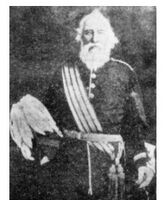Publications: The Theosophist, Vol. III, No. 8, May, 1882, pp. 192-196
Also at:
In other languages:
99
FOOTNOTES TO “THE PHILOSOPHY OF SPIRIT”
[The Theosophist, Vol. III, No. 8, May, 1882, pp. 192-196]
[The article is a review by Subba Row of William Oxley’s work The Philosophy of Spirit, which the reviewer examines “from the Esoteric and Brahmanical Standpoint.” H. P. B. has appended footnotes to certain sentences or words of the text.]
[Manvantara] The period of Regeneration, or the active life of the universe between two Pralayas or universal Destructions: the former being called the “day” and the latter the “night” of Brahmâ.
[Yaksha] The earth-spirit or Gnome.
[Gandharva] Akin to the Christian cherub or singing seraph. There are, says Atharva Veda (Bk. XI, Hymn V, 2), 6333 Gandharvas in their Loka.
[Ordinary initiate] An initiate of the preliminary degrees.
[Ahamatma] The “I am, That I am” of the Biblical Jehovah, the “I am who I am,” or “Mazdao” of Ahuramazda in the Zend Avesta, etc. All these are names for the 7th principle in man.
[Krishna . . . speaks of “Adi-Buddha”—the state or condition represented by Pranava—in the succeeding verses.]
Hence, the great veneration of the Buddhists for Bhagavadgita.
[“. . . . he speaks of Adi-Buddha, as if it were merely a state or condition.”]
“Adi-Buddha” creates the four celestial Buddhas or “Dhyans,” in our esoteric philosophy. It is but the gross 100misinterpretation of European Orientalists, entirely ignorant of the Arhat doctrine, that gave birth to the absurd idea that the Lord Gautama Buddha is alleged to have created the five Dhyanis or celestial Buddhas. Adi-Buddha, or, in one sense, Nirvana, “creating” the four Buddhas or degrees of perfection—is pregnant with meaning to him who has studied even the fundamental principles of the Brahmanical and Arhat esoteric doctrines.
[“The ancient Rishis of Aryavarta have taken considerable pains to impress upon the minds of their followers that the human spirit (7th principle) has a dignity, power and sacredness which cannot be claimed by any other God, Deva or angel of the Hindu Pantheon.”]
In view of this, Gautama Buddha, after his initiation into the mysteries by the old Brahman, His Guru, renouncing gods, Devas and personal deity, feeling that the path to salvation lay not in vainglorious dogmas, and the recognition of a deity outside of oneself, renounced every form of theism and—became Buddha, the one enlightened. “Aham eva param Brahma,” I am myself a Brahma (a god), is the motto of every Initiate.
[“Vyasa does not exactly mean a recorder; but . . . one who expands or amplifies.”]
In no case can the term be translated as “Recorder,” we should say. Rather a “Revealer,” who explains the mysteries to the neophyte or candidate for initiation by expanding and amplifying to him the meaning.
[“This term (Vyasa) was applied to the Highest Guru in India in ancient time; and the author will be able to find in the Linga Purana that the author of the Mahabharata was the 28th Vyasa in the order of succession. I shall not now attempt to explain the real meaning of the 28 incarnations therein mentioned. . . .”]
To one, who has even a vague notion how the mysteries of old were conducted, and of the present Arhat system in Tibet vaguely termed the “Reincarnation System” of the Taley-Lamas, the meaning will be clear. The chief Hierophant who imparted the “word” to his successor had to die bodily. Even Moses dies after having laid his hands upon


101
Joshua, who thus became “full of the spirit of wisdom of Moses,” and—it is the “Lord” who is said to have buried him. The reason why “no man knoweth of his sepulchre unto this day,” is plain to an Occultist who knows anything of the supreme initiation. There cannot be two “Highest” Gurus or Hierophants on earth, living at the same time.
[Mahatmas] “Grand Souls” in literal translation; a name given to the great adepts.
